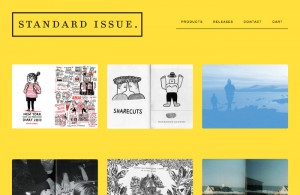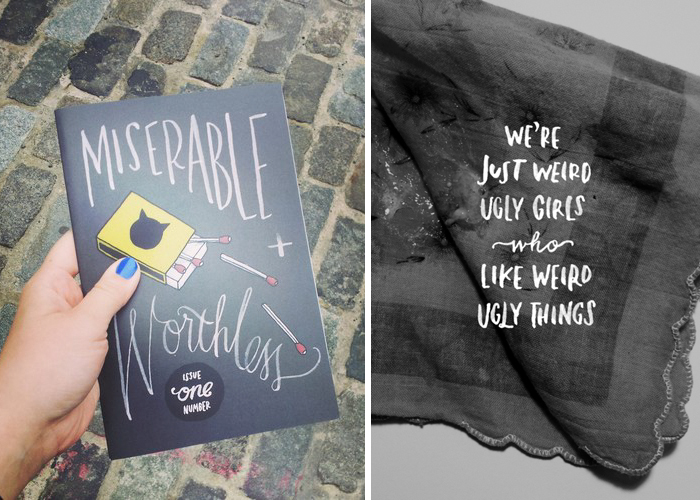
MR: What prompted you and Lindsay Eyth to start your zine, Miserable & Worthless?
TB: We started around the time were there were a lot of arguments happening about a lot of projects that were excluding women, and there were lists coming out of the best female [fill-in-the-blank noise] and there were some semi-misogynist lists of the best female [blank]…
“Hottest developers”
Yea, exactly, I got put on the hottest illustrators list, and it wasn’t even a picture of me, which was awesome, it was a picture of Meg…and I felt like the women that were being represented really favored a more wimpy, damsel-in-distress image, and I really wanted something that was more about who folks who did really kickass stuff and weren’t timid…just strong people. The whole thing started because I felt super depressed in New York and I didn’t feel really confident in my work, and under-confident, and I did this drawing of me driving a nail through my hand as I said “miserable and worthless” because I couldn’t do the drawing the way I wanted to, and I just thought it was funny because everyone feels super insecure about themselves and their work. I asked Lindsay if she wanted to do [the zine] with me, because I think of her as being a really strong, independent designer. So we did it together and she came closer to the tail end after I had already asked people, but the next issue will be a lot more collective.
I was going to ask, did the title come first or the zine?
Title. Also the phrase “we’re just weird ugly girls who like weird ugly things”. I felt like yea, a lot of the spotlights were on really stereotypical feminine artists. I like gross stuff and I wanted something that appealed to those sensibilities a little bit more.
I know, I love your stuff that has eyeballs on it, weird drippy things…
That’s funny, I feel like not a lot of people hire me for that. When I take it into portfolio reviews, people are like mmm next. But online, that’s what gets the most attention.
That’s interesting, I guess “marketable” stuff is a little different from what people actually like.
Yea, but then there’s Lisa Hanawalt who’s doing pretty much exclusively gross stuff right now, and she’s kicking ass doing that. And Hellen Jo is doing all girl gang-based stuff—she just had a zine that came out that was all girl-gang-based—and she does plenty of gross things and I feel like people are responsive to that. It’s more viewers who are responsive to that than people who are funding projects.
Could you talk me through your curation process?
There were pretty clear choices for me because I wanted it to focus on girls that I felt were doing something badass and capable, and girls that were doing something I admired. I’ve always been really interested in people who weren’t getting enough limelight and deserved it, so I also brought in some news students who emailed me awhile ago, and one of them was Angie Garland who I saw her stuff on Tumblr first and I reposted it and was like “who did this?!” because it wasn’t tagged. She ended up emailing me because she saw it on my blog and was like, “oh wow, I really love your work and I can’t believe you like it” but it was awesome…I really wanted to include her because I didn’t feel like she had already gotten very much buzz but she was so talented that she definitely deserved it.

Get 300+ Fonts for FREE
Enter your email to download our 100% free "Font Lover's Bundle". For commercial & personal use. No royalties. No fees. No attribution. 100% free to use anywhere.
Yea, I feel like Tumblr is the death of accreditation, so much flying around there and no credit at all.
It can also make people’s careers, though. I’m pretty sure that Wish Candy [NSFW], her career took off because of Etsy and Tumblr. She’s another person who, her subject is really limited—girls—and it can sometimes be crass or violent. But she was really well received because of that audience…I don’t know, I feel like Tumblr users are really obsessed with seeming like they made the content, or they plucked this out of obscurity, and it’s not that they actually say that they made it but they want to resist saying that they found it somewhere, to give up their sources.
They’re the “tastemakers”.
So, how’d you go about finding a printer?
Well, I had been in a zine that Leah Goren curated called Sad Girls, and she gave up the printer for that, which was awesome, they’re a printer based out of [Minnesota]. Actually, I really recommend using Shapco Printers in Minneapolis. They actually do a lot of gallery-quality work and they’re super-friendly and willing to work on any projects, especially art projects…and I think that’s where we’re going next.
How’d you find those guys?
I went to school at MCAD, and they were the natural choice. I’ve been talking to this guy, Ken, who works there, and he’s the most enthusiastic ever so he makes me want to give him more business because he’s just super-pumped…
What was the most challenging part of getting the zine together, and how’d you work through it?
I’m the kind of person that is really enthusiastic at the start and I’m up to doing whatever, and it’s hard to follow through—I mean, sometimes. Obviously I follow through (don’t think that I don’t finish projects!). Sometimes it’s just easier for me to start a project than to keep going. It was really helpful to have Lindsay on board too, who was really excited about it, and that way we kept the fire alive by chatting back and forth. She would do type, and I’d be like, “wow, that looks great”…I also feel like having a pretty set deadline on submissions helped keep me on track. And we premiered Miserable & Worthless at Brooklyn Zine Fest, so it’s always good to have a deadline like that, too, where either you get it done or you have nothing at the table.
Actually, that’s a good segue into my next question: do you find tabling at zine fests to be worth the time and cost?
Totally. When I was in college I did the Minneapolis Zine Fest all the time. Every summer it fell on my birthday, and that’s how I spent my birthday, at zine fest. I remembered when I first started, I didn’t even know how to do printing on both sides, so they would be like, one side had something printed on it and the other side was totally blank. My friend Tom Kaczynski, who’s a really great comic artist, was like, “do you want me to show you how to do this?” But even though it was a really crappily-printed zine, it got my interests and tastes out there and it was received really well. The work that I was doing at the beginning was really simple photocopies and they cost me a penny apiece and I was only selling them for a dollar. But it was definitely worth the experience, you meet so many people and it’s good practice for talking to people at conferences.
That’s a good suggestion, some people fret about how do I talk to people, how do I approach my heroes, “network”.
That’s really funny, Gemma Correll and I just tabled at APE in San Francisco—we get along really well—we were seated next to these two girls whose names were Tiffany and another girl whose name started with a “G”, and one had blonde hair and one had dark brown hair. They really were our dopplegängers, and they were super prepared and had giant vinyl signs behind them, and they were really perky and stood up the whole time and really made the sell…and Gemma and I are kinda crouched over our table, drawing and lamenting the fact that our dark mirrors were right next to us, probably raking in thousands of dollars and we’re just chillin’.
That sometimes makes you more accessible, though.
Yea, I don’t know, to me a zine fest is not something where you have giant vinyl posters. You know, it’s like a table where you set out your offerings, maybe it’s tote bags, photocopied zines, maybe it’s some books. Otherwise I think of it as being a pretty low-key affair and I feel like especially because the zine fests I started at were anarchist zine fests turned into like comic books, but this was definitely more a sci-fi comic fest, that’s a whole different audience that I’m not necessarily trying to speak to.
Pretty different work.
They were super talented, but the girls at the table next to us were doing giant portraits of dragons and warriors slaying them and that’s not what we do at all.
So you plan on doing another issue [of the zine], is there anything you can tell me about that, beforehand?
On the initial issue of Miserable & Worthless, we had a theme, but it felt like it wasn’t necessary because it felt like “miserable and worthless” was a theme enough. So, yes, we do have more plans, we want it to be a lot larger. Thinking about maybe doing a Kickstarter. We want to include more than just photographers and illustrators, which is what we had done before. We want to include a lot more designers and have interviews, stuff like that.
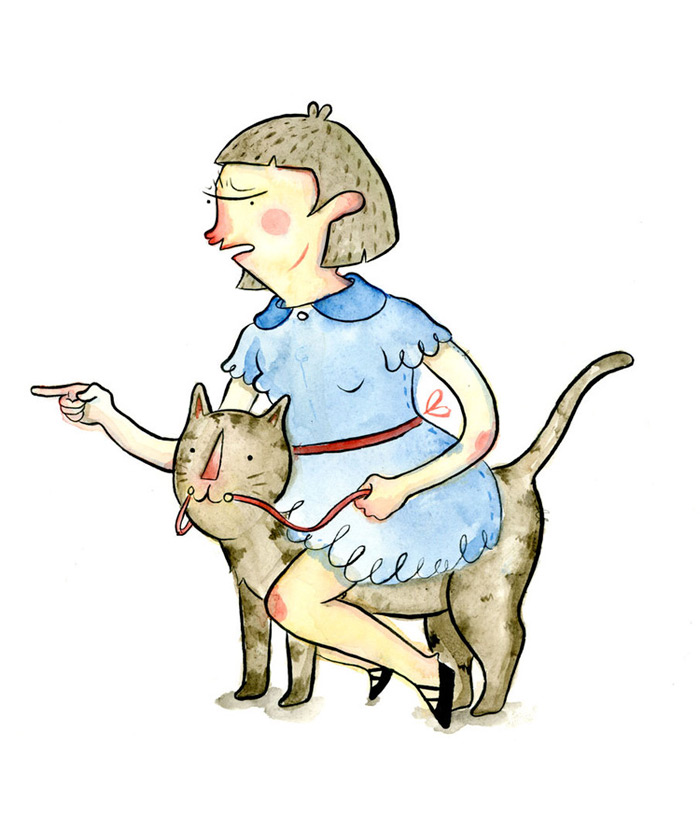
Tuesday Bassen for Got a Girl Crush
How often do you submit work to other people’s projects?
Something that they ask me to do, or just out of the blue?
Either one.
I never submit projects out of the blue to a “call for entries” for zines, just because I feel like I don’t really have enough time to do that, unless it’s a friend’s project that I’m really committed to, and also I want to get paid for my stuff. Unless I’m asked specifically, I don’t really do it. But if I am asked specifically…I just did the cover for Got A Girl Crush magazine, which is run by some of my friends; it was my pleasure to do that. I’ve been in several zines and stuff like that since, and I’ve been really happy to be involved with that. I feel like that’s a good chance to make work that you really like.
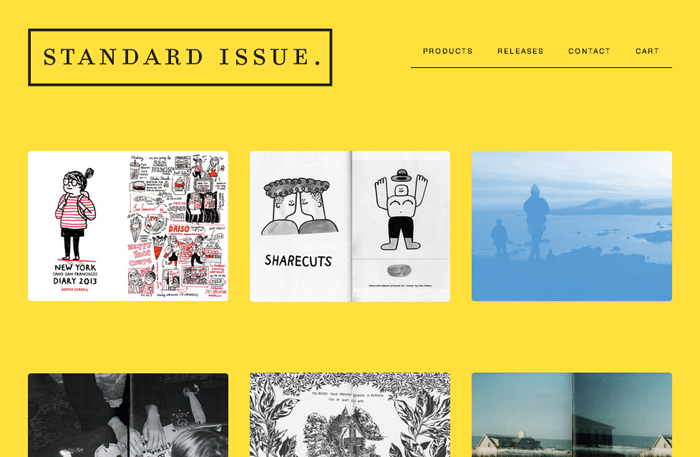
Tuesday and Jansen’s Standard Issue Press
Miserable & Worthless is now rolled under your new venture with Jansen Cumbie, Standard Issue Press. Can you tell me how that got started?
Jansen used to co-run a tape label called Mirror Universe, and it was a really awesome tape label and they put out bands like Toro y Moi, Washed Out, Mr. Jenkins, stuff like that was a lot of their first releases; I really admired them as a label. And then he decided he wanted to do something. With the success of Miserable & Worthless, I was really interested in doing more of a holistic press, not just for my releases but for other zines too, so it just seemed natural to combine those. And obviously we’re dating and live together, so it’s really easy to combine that into what we do. Neither of us really has an off switch, and our off-time is making stuff anyway. We share a studio at home as well.
What is your studio space like at home?
It’s the largest room in our house, and one side of the room is Jansen’s desk with a ton of musical equipment; the other side of the room is my desk, which has an iMac on it, a scanner, printer, paints. And we built shelves on the wall to hold our zines and equipment because we have so much. It’s a really good place to do whatever you want. Between the two of us, we run the gamut of artistic interests. I have clay, I have ceramics, I have paint.
Oh, that’s a dream. Are all the zines and cassettes published or released specifically by Standard Issue?
Yes, they are released specifically by Standard Issue. We let artists retain rights, and we retain first-issue rights. Beyond that, we reprint if they want to, re-issue if they want to.

Illustration (by Tuesday) for Jansen’s previous label, Mirror Universe
Is that knowledge that Jansen has from his prior label, working through those rights issues?
Yea, absolutely. He handles the music side of things, and I handle the zine side of things. We have crossover sometimes, too. He made a photo zine that we put out, and I’ll do work for bands that we put out. I did the cover art for Southern Femisphere, who’s based in Charleston, I really love their stuff. So there’s some crossover but mainly he talks to musicians and I talk to artists because that’s where our knowledge bases are.
Why cassette tapes?
It’s funny to hear me describe why and hear Jansen describe why, because Jansen will be like, “they move”. I feel like that’s the answer that he gives to older people who want to know the financial side. I think cassette tapes because: it’s really important for us to have a tangible art object, and printing vinyl is out of the question because of how expensive it is. We want something tangible but we didn’t want to go the route of having a T-shirt with a free music download. That’s not really our style. Cassettes are really popular, especially in the DIY scene of New York, and it just felt natural to us.
Have you ever had a difference of opinion, and how’d you work through that?
Not really.
Really?!
Yeah, usually Jansen is like, “[music artist] wants to do a tape”, and I’m like, “oh, great! Can I do the artwork for it?” Or I’ll say, “Gemma Correll is putting out a zine with us, it’s actually at the press right now”. I feel like we have pretty complementary tastes, so we rarely argue about that. Unless it was something really out of character, like if we were putting out a Jack Johnson tape and he didn’t tell me, I’d be like, “oh, NO”. But I don’t think that would happen. We’re actually putting out a tape that I OK’d without talking to him: my good friend Phoebe Little from Lincoln, Nebraska. She just got back from India, she recorded a lot of old Indian songs from the radio. We’re releasing an art project with the tape attached.
What plans do you have for Standard Issue, how would you like to expand?
That’s really funny that you say that because being in Charleston*, we’ve been talking about the opportunities that would be afforded to us if we moved away from New York City, and I think that we eventually—not in the near near future—we’d like to open up a store front, and have zines, tapes, probably records for sale too that weren’t just ours, probably my ceramic line, pulling all these things together that you really love…pulling together artists that we really believe in. I feel like a shop is a natural progression. We were fantasizing about this store front in Charleston, we could have studio in the back and storefront in the front.
* For context, this interview took place in Charleston, South Carolina.
I loved mixed-use spaces, I feel like people are really intrigued, like, “what is this? What do you guys do here?”
A shop that Jansen and I really like was called Easy Tiger in Toronto, and they served coffee and cookies and other stuff, but they also had shoes, and they had ceramics, it was basically an everything-we-like shop. For the owners, they were like, “ehh we just liked it!” And we really liked it, and I feel like that’s what Standard Issue will eventually become. Even if it doesn’t become a physical store right away, it would be really fun to expand our web presence to be more of a web shop.
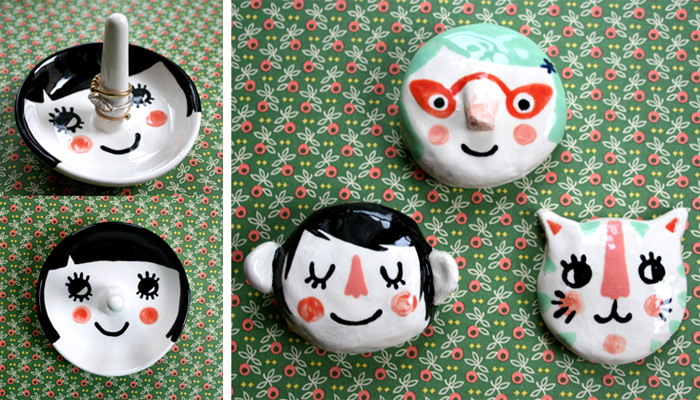
Ceramics by Tuesday Bassen
I’m excited to see what you guys do with it. You sell cheerful little ceramics on the side. How did you get started with ceramics?
I’ve been doing ceramics since I was about seven years old, maybe a little bit earlier than that. My mom owns a few pottery stores in Nebraska, so I grew up with a kiln. It was recently that I re-discovered a sculpted face that I had made as a kindergartner. It’s kind of terrifying, you hang on the wall by its eyeball, but it’s a self portrait. It’s got long hair and big eyelashes, because it’s through a five-year-old’s paintbrush, not that I actually have big hair and big eyelashes. When I found it, I was like, huh. I can do this, now. So I started up my Etsy shop with ceramics making hand-sculpted faces that you could hang on the wall, that you could hang through a nail-hole in the back. I posted twenty and they sold within the first couple hours…and I was like, “oh, maybe I can do something with this”. So I started doing plates and stuff like that.
What do you like about the [ceramic studio] space?
The main draw for me was, I wanted to find a space I could work at in Brooklyn that was more my own, and less me renting a space from a larger facility. I used to have a space at Choplet, but that’s better for beginner-level students who are taking classes. I had a positive experience, but I was looking for something quieter, where I could rent my own booth, my own station. The most positive thing is working with other people who are making amazing things…I think Helen Levi is leaving the space but she’s an amazing artist…she’s probably expanding because her line is expanding so quickly. Josephine Noel who does Recreation Center is doing amazing things. Small Spells, who’s Rachel Howe. And Isaac Nichols, who runs the space and makes awesome boob pots and face vases.
[Somewhere around here we’re interrupted by some creepy dudes at the next table over. Excuse me, we are busy being badass.]
…Courtney Reger who does Sandwich Shop. It feels positive to feed off the energy.
I feel the same, it’s about who you’re around that really makes it. What is your ceramics process like? Do you work from a drawing?
I have the ringholders, which is one design that I do over and over again. But it’s based off my drawing style, and how I would draw a girl’s face, using the ceramic shape to inform the design. With plates I usually vary what the face looks like, and I’ll draw right on the ceramic before I paint it. And my process is extremely technical, I use a Crayola marker to draw on because it’s water-based, and I use under-glazes, which means they fire at a lower temperature than a thick, viscous, high-glaze clay. After I’m finished, I dip it in a clear glaze, which means everything’s smooth, shiny, and food-safe. Then I fire it in the kiln, which reaches thousands of degrees. Afterwards I sand off little stilt marks on the back; I use little stilts to make sure it doesn’t stick to the glaze shelf, otherwise the glaze would stick to the shelf because it gets so hot. Then I ship it off!
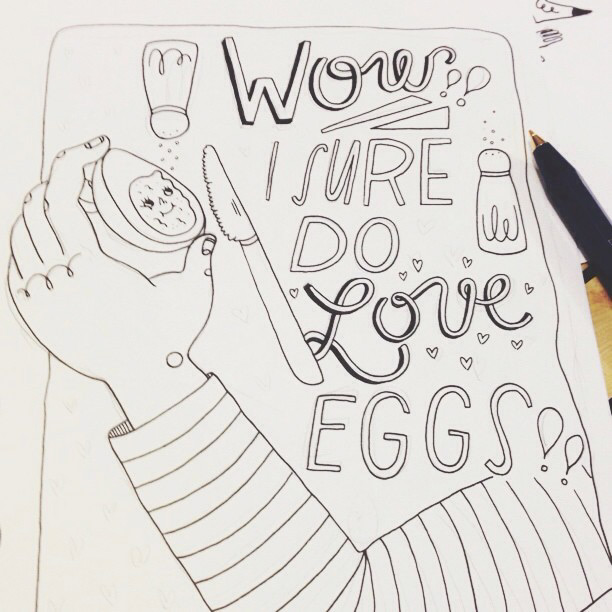
Process shot from The Velvet Cave #9.
Well, that’s a really succinct way of describing a long process. What other products do you want to make in the future?
I’m obviously interested in producing more zines. I have a zine that I’ve been working on for awhile; I have a series called The Velvet Cave. That’s my personal zine that I put out, I used to put it out quarterly and now I’m probably putting it out once a year. So I want to work on that. I want to put out some books with people. More products people can use—I feel like there’s so many things in the world that are crap and that nobody can use, and that’s part of what brings me to ceramics. I wanted something that was beautiful and also functional. Maybe not even beautiful, just quirky and cute, something that had my style, but people could use it so it didn’t feel like a waste. I’d like to expand my line to be more things like that, things like pencil pouches, because I need those, I’ll buy those from other independent artists online. So pencil pouches, scarves, more ceramics, things like that that wouldn’t go to waste, but would beautify an everyday experience.
You should make a coin purse, I need one of those!
That’s a really good idea…I’m working on pouches right now, but I didn’t think of coin purses. Duh!
Do you have any specific goals for 2014, anything you’d like to accomplish?
It’s funny because I’ve stopped thinking in terms of the next year, I’ve started thinking—since graduating college—in terms of five-year goals. My goals for the next five years are to expand my personal and ceramic line. I have steps that I take every day to make that happen, I don’t know that I have anything specific in 2014 that I need to meet. I’m a very goal-oriented person, but I’m giving myself a lot of time to complete it so I can do it right.
Which badass ladies have been inspiring you lately?
Well, I felt really inspired by the badass ladies site. I’m not just saying that to suck up, I was like, “this looks really good”. Whenever I see something really cool happening, especially with other women, I get a kick in the pants. Like, ahh I should be trying harder! So many awesome things that people are doing and I have to make sure that I’m giving my all. I also really like Got A Girl Crush, that’s another badass lady news source. More specifically, I really like Falconwright, which is Sandi Falconer and Danielle Wright; they’re combining their talents of sewing, fabricating, and illustration and screenprinting into a really kickass leather goods line. Those guys are totally awesome. I’m forever girl-crushing on my friend Gemma Correll, I think she’s really great, funny, and definitely an advocate for herself. I really love Helen Rice progress as a really great designer, as she’s being recognized more and more, and blossoming into a really important figure in the design world…I love reading interviews with her because she is so well-spoken, and she’s obviously a kind and wonderful person. I’ve been really into Heather Benjamin’s work lately. She’s based in New York, she does really great grotesque work, and I really admire that she’s known for grotesque work because I let go of that right out of school. I see her stuff, it gets me really excited. Yea! F*** yea! You don’t even care, it’s so awesome! We can all aspire to care a lot less of what other people think of us.
We end up chit-chatting about interviews vs. presentations. I’m better at presentations that I’ve prepared for, while Tuesday is more comfortable off-the-cuff:
I feel like I’m having a more honest discussion with someone, instead of preparing ahead of time, where I feel like I need to say something with really great impact, but I end up giving a really wimpy presentation because I get nervous. It’s not that wimpy, just not as good as I’d like it to be. I do better in a Q&A-style session. I wonder if I surprised the students at Portland State University when I talked to them, because when I talked to Kate Bingaman-Burt, she said I could do whatever I want to, and I could just do a Q&A, or a presentation. And when she said “just Q&A” I was like, “YES. That’s what I’m gonna do.” Anything I could say ahead of time wouldn’t even be that helpful. I could give a brief introduction of who I am and what I do, but I just want to be open for anyone to ask me anything, ANYTHING. I’m not embarrassed about anything, whatever your burning questions are.
On that note, if you have anything you’d like to ask Tuesday, she welcomes burning questions at hello [at] tuesdaybassen [dot] com. Thanks for talking, Tuesday! Can’t wait to see where you take your projects.

